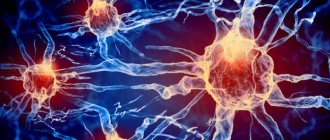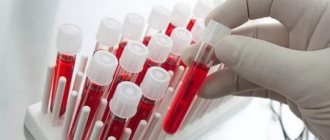Testosterone in men is produced by the genital glands located in the testicles. Under its influence, the development of the organs of the reproductive system and secondary sexual characteristics is enhanced. It stimulates sperm production and is also responsible for sexual desire. The hormone helps build muscle and bone mass. Let's talk about it!
The name of the main hormone in men comes from the words testicle and steroid. By its chemical nature it is classified as a steroid.
In higher vertebrates and humans, it is produced by the glands of the genital organs, more precisely, by the testes, as well as by the liver; a smaller amount is synthesized by the cells of the reticular layer of the adrenal glands.
Intermediate products of hormone biosynthesis are progesterone and cholesterol. The normal level of testosterone concentration in the blood in men is 0.5-0.6 mcg/100 ml. During the day, a mature male body produces approximately 15 mg.
The role of sex hormones in the female body
The content of the article
Puberty, the menstrual cycle, pregnancy, menopause or in general: health and beauty - all these processes and conditions depend on the specific level and constant fluctuation of female sex hormones. They are responsible not only for appearance, characteristic female features or reproductive abilities, but also for many other important processes occurring in the female body.
Hormones can either improve or worsen the condition of your skin and hair; positively and negatively influence overall well-being; increase or decrease libido and finally promote or hinder pregnancy and are responsible for various diseases.
For a woman's body to function effectively, it needs a stable hormonal balance. This is why it is so important to know the functions of individual female hormones, familiarize yourself with their standards, testing forms, and options for monitoring the correct concentration in the body.
Learn what names like estrogens, progesterone, androgens, and prolactin mean, and find out what these hormones do in the body.
Serotonin: happiness and immunity
Serotonin is essentially a happiness hormone: it takes care of our relaxation and feelings of contentment. It also stimulates the immune system and therefore strengthens the body's defenses. Under the influence of serotonin, we are calm and see the world through rose-colored glasses.
This is used in the treatment of depression, which is often caused by a lack of serotonin. Such patients are prescribed serotonin reuptake inhibitors, which prevent the body from quickly destroying serotonin that has already been produced.
It also plays a significant role in the feeling of sexual pleasure. It also promotes wound healing by constricting small blood vessels and thereby reducing bleeding. So being happy is not only wonderful, but also good for your health.
Female sex hormones are the culprits of a long-term hormonal storm
You could say that hormones control your entire life. Although this is a simplification of the concept, it is no different from the truth. The endocrine system is complex and is responsible for a number of functions in the human body, and overall it directly influences hormonal balance. Therefore, the endocrine system is often tested first when symptoms, both physical and mental, are present.
Women who, both at puberty and throughout their adult lives, are constantly influenced by hormonal fluctuations can tell a lot about this. After all, female sex hormones are primarily to blame for emotional breakdowns, headaches and other unpleasant situations.
Hormonal fluctuations
Endorphin: why men fall asleep after sex
What makes endorphin different from other neurotransmitters released during sex is that it is like a drug. This is clear from its name, which means nothing less than “endogenous morphine.” Morphine, as you know, is an extremely powerful painkiller.
So endorphin reduces pain and thereby improves sleep. Our body produces it in huge quantities when we laugh, eat something tasty or actively engage in sports - and, of course, during sexual intercourse. Therefore, after sex, men often fall asleep peacefully.
How to identify female hormones among common hormones and distinguish them from male ones?
It’s worth starting with what sex hormones are in general.
Sex hormones, also called steroid hormones, are secreted mainly by the female and male gonads, ovaries and testes, respectively, with the participation of the pituitary gland, hypothalamus and adrenal glands.
Already at this stage, it can be noted that sex hormones are produced in both the female and male bodies. Whether we call them female or male depends primarily on their concentration in the body of both sexes and on the performance of certain roles. And it is the level of these sex hormones that determines the development of all broadly understood male and female characteristics.
Hormones influence, among other things, a woman's or man's appearance and the proper functioning of the reproductive system (male and female), as well as numerous processes occurring in the human body.
Among female sex hormones, the most important are:
- estrogens,
- progesterone,
- prolactin,
- androgens.
In addition to the above, gonadotropic hormones must also be present, that is, FSH (follicle-stimulating hormone) and LH (lutropin). It is worth adding thyroid hormones to this set, including triiodothyronine (T3), thyroxine (T4) and calcitonin (CT).
Female hormones are primarily responsible for:
- puberty and the development of specific feminine qualities, including body structure,
- adequate ovarian function and their decline during menopause,
- regulation of the menstrual cycle,
- pregnancy and its proper course,
- metabolism,
- proper blood clotting,
- well-being, which is often associated with changes in mood and a range of different emotional states, and sometimes with mental health,
- calcium deposition in the skeletal system,
- libido, that is, the feeling of sexual desire,
- proper functioning of the sebaceous glands, which also affects the quality of skin and hair,
- lipid metabolism and many other processes.
Each of the hormones performs specific functions, but they are closely related to each other, which is why it is so important to maintain hormonal balance at the desired level.
Plateau
The plateau phase is what happens between arousal and orgasm. If there is no orgasm, resolution occurs after a plateau. In another way, the plateau phase can be called the highest degree of excitation. During this stage, the pulse and breathing continue to increase, muscle pressure and tension increase, the clitoris becomes more sensitive, and the Bartholin glands in the vagina secrete more lubrication.
The activity of different areas of the brain increases. One of them is the amygdala. It is responsible for the perception of visual images and emotions. During the plateau phase, activity in the area of the brain where memories are stored decreases. This probably happens because at this moment we don’t care at all about memories and the emotions associated with them.
Estrogens, or hormones of femininity, not only from the point of view of beauty and figure
It is likely that no sex hormone other than progesterone is associated with femininity as strongly as estrogens. It is estrogens that have a huge impact not only on the development of female sexual characteristics, but also on many key processes in the female body.
Estrogens are actually a group of hormones that include the following compounds:
- estrone,
- estradiol,
- estriol,
- esthetrol (produced only during pregnancy).
In women, these hormones are produced mainly in the ovaries, more precisely in the Graaffian follicles, as well as in the corpus luteum or placenta. They are produced in smaller quantities in other parts of the body, such as the adrenal glands, liver, breast glands and fat cells.
The most important functions performed by estrogens in the female body include influencing the development of sexual characteristics already at the level of fetal development, immediately after birth and during adolescence. This means that these hormones are responsible for the typical female body structure and entire figure, the development of the genital organs, mammary glands or redistribution of fatty tissue, as well as the development of the psyche and sexual desire.
In addition, estrogens, including:
- regulate the menstrual cycle and fertility,
- have a positive effect on lipid metabolism, increasing the level of “good” cholesterol (HDL) and reducing con (LDL),
- increase calcium deposition in bones, stimulating their growth; thus preventing osteoporosis,
- accelerate metabolic processes,
- increase vaginal hydration,
- increase blood clotting,
- have a positive effect on protein absorption,
- influence the growth of adipose tissue and its metabolism,
- are responsible for the appropriate level of libido,
- affect the emotional state,
- increase the excitability of the smooth muscles of the uterus and fallopian tubes,
- responsible for converting carbohydrates
- stimulate the functioning of the mammary gland,
- regulate body temperature,
- influence the proper permeability of cell membranes,
- increase skin elasticity and reduce sebum secretion.
The physiological role of estrogens is especially important in certain phases of the menstrual cycle. They are responsible for the growth of the lining of the uterus (endometrium), its proper blood supply and nutrition, thereby preparing it for implantation of a fertilized egg.
This is directly related to fluctuations in estrogen levels during certain periods of the menstrual cycle. The lowest value is observed during menstrual bleeding followed by a gradual increase until it reaches a peak during ovulation. Without this process it would be impossible to get pregnant or maintain a pregnancy.
Estrogens also play an important role in the production of luteinizing hormone (LH), which is involved in ovulation and is responsible for the formation of the corpus luteum.
These hormones make it easier to obtain a fertilized egg and then help the fetus grow and develop. But during pregnancy itself, estrogens also affect:
- development of milk ducts in the mammary glands,
- breast enlargement and figure rounding,
- improvement of skin and hair condition,
- awakening the maternal instinct.
Breast enlargement
During pregnancy, estrogen levels gradually increase. After childbirth, it drops sharply, which may be associated with a significant decrease in the mood of the young mother (the so-called blues, which may be associated with postpartum depression).
A decrease in estrogen is also directly related to menopause. During this period, the hormonal activity of the ovaries ceases, which leads to a significant decrease in estrogen production. As a result, typical menopause symptoms appear and the risk of osteoporosis and heart disease increases.
Signs of deviation from the norm
Every day, hormonal levels control a woman. It affects not only her mood, poise, femininity, but also her appearance, the presence and absence of sexual desire.
The amount of androgen in a woman’s body affects her appearance. Both a deficiency and an excess of these components can provoke a sharp start of the aging process, dryness and thinness of the skin, an increase in fat in the abdomen and arms, and joint pain. Hair loss and increased fat content, deepening of the voice, rapid growth of muscle tissue are reasons to check the amount of testosterone in the body. To normalize its amount in the blood, it is necessary to follow a daily routine and adjust your diet.
A persistent feeling of hunger, a change in hair color, and a decline in sexuality indicate estrogen deficiency. Its deficiency manifests itself in dryness, burning and other unpleasant sensations during sexual relations. These elements can be balanced with the help of hormone therapy after diagnosis by a gynecologist and endocrinologist.
What should be the correct estrogen concentration?
It all depends on the phase of the menstrual cycle, as well as the stage of development, age and health of the woman. In different periods, estrogen levels are different.
Estradiol values:
- follicular phase: 30–120 ng/l (110–440 pmol/l),
- ovulation: 130–370 ng/L (477–1358 pmol/L),
- luteal phase: 70-250 ng/l (257-917 pmol/l),
- postmenopausal period: <10 ng/l.
Estrone:
- in the reproductive period 17-200 ng/l,
- during the postmenopausal period 7–40 ng/l.
Estriol: less than 80 ng/l.
Estrogen concentrations are checked in a diagnostic laboratory. A blood sample is analyzed. You must come for the examination in the morning on an empty stomach. It should also be remembered that the values in the test results should be directly compared with the standards indicated on them, and the correct interpretation should be left to the discretion of the doctor.
What to do if your estrogen levels are too low or too high?
Both excess and deficiency of these essential hormones can have negative consequences.
Excess estrogen most often occurs in women who are obese, have diabetes, have hypertension, and have certain types of cancer, such as ovarian cancer. This is also associated with taking inadequate doses of estrogen-based drugs.
The effects of excess estrogen include:
- menstrual irregularities,
- headaches, seizures, including migraines,
- nausea and vomiting
- excessive growth of the endometrium, which can lead to cancerous changes,
- increased risk of blood clots and embolisms,
- swelling,
- breast enlargement,
- weight gain,
- general malaise,
- mood swings.
Estrogen deficiency is physiological in women during menopause, but pathological in women of reproductive age.
This may contribute to the following disorders:
- irregular menstrual cycles or their absence,
- infertility,
- disappearance of 2- and 3-row sexual characteristics,
- vaginal dryness,
- urinary tract infections,
- urinary incontinence,
- hot flashes and profuse sweating,
- sleep disorders,
- decreased sexual desire,
- mood instability and depression,
- loss of breast firmness,
- deterioration of the quality of the skin,
- calcium disorders and osteoporosis,
- heart disease as a result of high cholesterol.
Progesterone is a hormone necessary for basic tasks, ovulation and pregnancy.
Progesterone, mentioned in connection with estrogens, is an equally important female hormone.
Progesterone
Progesterone, once called lutein, is secreted by the ovaries, more specifically the corpus luteum in the luteal and early stages of pregnancy, and the placenta in later stages of pregnancy. To a lesser extent, it is produced in the adrenal cortex and central nervous system.
What is this extremely important female sex hormone responsible for? The main tasks of progesterone:
- control and regulation of the menstrual cycle,
- influence on the onset of ovulation,
- preparing the uterine mucosa for the arrival and implantation of a fertilized egg,
- maintaining pregnancy throughout its entire duration,
- relaxation of the enlarging uterus in the second half of pregnancy and inhibition of its contractions,
- maintaining the correct structure and function of the cervix during pregnancy,
- suppression of excessive growth of the endometrium under the influence of estrogens,
- in combination with estradiol, stimulates the mammary gland and prepares it for lactation.
The effect of progesterone on a woman’s body depends primarily on the phase of the menstrual cycle.
During the follicular phase, progesterone levels are low and the ovaries primarily produce estrogen. Its level increases at the beginning of ovulation, which is a sign of ovulation itself. The highest level of progesterone is reached when the egg develops into the corpus luteum.
If the embryo is not fertilized and implanted, the concentration of progesterone decreases and the so-called luteolysis of the corpus luteum occurs. Under physiological conditions, a sharp decrease in progesterone levels will lead to menstrual bleeding.
It is easy to notice that progesterone levels fluctuate constantly. Progesterone levels at individual stages of the cycle are as follows:
- in the follicular phase: 0.28–0.72 ng/ml,
- in the perovulatory phase: 0.64–1.63 ng/ml,
- in the luteal phase: 4.71–18.0 ng/ml.
The concentration of progesterone during pregnancy varies and is:
- in the first trimester: 11.0-44.3 ng/ml,
- in the second trimester: 25.4-83.3 ng/ml,
- in the third trimester: 58.7–214 ng/ml.
During menopause, low progesterone levels (according to tests).
Both too low and too high levels of progesterone can impair basic body functions. Progesterone deficiency is one of the most common causes of fertility problems.
When it's not enough:
- menstruation becomes irregular, more abundant;
- there may be severe pain in the lower abdomen, uterine cramps, spotting or vaginal bleeding;
- there is a problem with pregnancy;
- problems with excessively dry skin and excessive hair loss are visible;
- possible increased symptoms of premenstrual syndrome (PMS);
- pregnancy may end in miscarriage.
The cause of too low progesterone levels may be a deficiency of the corpus luteum or problems with the placenta, dysfunction of the pituitary gland or hypothalamus, or poisoning during pregnancy. If excess progesterone is not associated with physiological changes such as pregnancy or the luteal phase, it may indicate a number of problems, including:
- liver failure,
- polycystic ovary syndrome,
- adrenal-genital syndrome,
- ovarian or adrenal cancer.
Polycystic ovarian syndrome
Too much progesterone may indicate swelling caused by water retention in the body or varicose veins.
Prolactin, an extremely important female hormone during pregnancy and lactation
A hormone that is associated with reproductive effects in both women and men is prolactin (PRL).
It is a peptide hormone, also known as luteotropic hormone (LTH), that is produced primarily in the anterior pituitary gland and to a lesser extent in the uterus and breasts in women, the prostate in men, and the skin or fat tissue.
Over the years, scientists have assigned this hormone more than 300 different tasks, which can be divided into:
- reproductive,
- metabolic,
- regulatory - in the field of fluids (osmoregulation), the immune system or behavioral functions.
Why is prolactin called the female hormone? Mainly because it is responsible for many important functions during pregnancy and lactation. First of all, the appropriate concentration of this hormone supports the functioning of the corpus luteum, which is responsible for the production of progesterone, another essential hormone. to maintain pregnancy.
It is also worth knowing that the name prolactin itself comes from a direct connection with lactation, that is, with the function of stimulating milk production, which occurs in response to breastfeeding. Prolactin stimulates the growth of mammary glands during pregnancy and causes lactation.
Moreover, in lactating women, it suppresses the secretion of follicle-stimulating hormone (FSH) and luteinizing hormone (LH), thereby blocking ovulation and menstruation, especially in the first months of the postpartum period.
The regulation of prolactin levels is influenced by dopamine (a hormone secreted by the hypothalamus) and estrogens.
What are the normal prolactin levels? The concentration should be between 5-25 ng/ml, but should be assessed based on the standards provided by the specific test results. Another thing is that prolactin does not always remain the same. It is quite natural, for example, to increase prolactin during pregnancy and breastfeeding.
Fluctuations in this hormone are also observed during the menstrual cycle. At first it increases slightly, and in the second half it gradually decreases. Thus, we can distinguish different prolactin norms for women. It should be:
- in the follicular phase below 23 μg/l,
- in the luteal phase below 40 μg/l,
- and in the third trimester of pregnancy up to 400 mcg/l.
It is also worth mentioning that prolactin values can be expressed in different units. Mainly in ml/ml and in hives/ml. They are recalculated using the formula 1 ng/ml = 20 mIU/l.
Moreover, prolactin concentration is also related to the circadian cycle. In the second half of the night, hormone levels rise, reach a peak in the early morning, and then gradually decrease.
Changes in the level of this hormone are also influenced by stress, sexual intercourse, rich food or exercise.
Any abnormalities require a prolactin level test. The examination involves analyzing a blood sample taken in the morning on an empty stomach, preferably between 8 and 12 o'clock.
What does excess prolactin mean? Everything depends, of course, on the conditions described above. However, even if a woman is not pregnant, elevated prolactin levels may mean:
- more than 25 ng/ml - the occurrence of irregular periods and non-ovulatory cycles,
- more than 50 ng/ml - complete cessation of menstruation,
- more than 100 ng/ml - risk of pituitary tumor.
Too high prolactin levels can manifest as:
- menstrual irregularities, including scanty bleeding with a tendency to stop completely,
- breast pain and tenderness,
- galactorrhea, that is, leakage of milk from the nipples, even outside of pregnancy or breastfeeding,
- decreased libido,
- Vaginal dryness, which can lead to pain during intercourse.
Decreased libido
It is worth knowing that excess prolactin in women can lead to problems with pregnancy. Hyperprolactinemia, the so-called increase in the level of the hormone prolactin, may have the above physiological background:
- during pregnancy or breastfeeding, during sleep or exercise,
- for pathological conditions caused by various diseases, including pituitary adenoma, renal or liver failure, hypothyroidism or taking certain medications.
Hypoprolactinemia, that is, a decrease in prolactin concentration below normal, is diagnosed much less frequently. This mainly occurs in people suffering from hypopituitarism.
Adrenaline: heart beats faster
Here it is, right in front of us, the object of our passion. The heart begins to beat faster and stronger, we are filled with energy, nothing and no one can stop us. Adrenaline, a stress hormone produced by the adrenal glands, is to blame for this. Thanks to him, in a split second we are ready to fight, but also to escape. If we are being chased by a hungry lion - which, fortunately, does not happen often - then it is adrenaline that allows us to run fast, like Forrest Gump. And if we are attacked, then it gives us strength and determination, the existence of which we did not even suspect in our own souls.
It's funny, but something similar happens when we see a loved one or even just think about him. At the same time, adrenaline expands the bronchi so that more air can flow in, and the pupils so that we can see better. Adrenaline speeds up breathing, increases blood pressure and makes a healthy heart beat stronger and faster every second (during sex, even more than 120 beats per minute). For our cardiovascular system, it serves as something like a fitness machine. In addition, this stimulant increases blood sugar levels, and therefore our strength.
For a weakened heart, unfortunately, there is also danger here, because in a stressful situation, adrenaline overstrains the heart. For example, if, while taking this hormone as a medicine for emergency indications, you allow an overdose, the blood supply to the heart may be disrupted, resulting in heart failure, a heart attack, and in the worst case, unexpected cardiac arrest. Another side effect of sex with a weakened cardiovascular system is stroke, cerebral hemorrhage, the most common cause of death during lovemaking. When we get very excited, blood pressure rises, which the damaged brain vessels don’t like.
Gonadotropins, that is, hormones necessary for proper childbirth
The very name of gonadotropic hormones suggests their key role in the human body. They are responsible for stimulating the activity of the human gonads, that is, the female ovaries and male testes. They are secreted by the anterior pituitary gland.
Gonadotropins primarily include:
- follicle-stimulating hormone (FSH), that is, follicle-stimulating hormone,
- luteinizing hormone (LH), called lutropin.
This group of hormones also includes human chorionic gonadotropin (hCG), released during pregnancy.
The FSH hormone in women is intended to stimulate the growth of ovarian follicles, control their development and regulate the functions of the corpus luteum. Stimulates the secretion of estrogens by granular cells of ovarian follicles.
Levels of stimulation of blood follicles depend on the woman’s age and the phase of the menstrual cycle. FSH norms in women are:
- in the follicular phase - below 12 IU / l,
- in the ovulation phase - from 20 to 90 IU / l,
- in the luteal phase - below 10 IU / l,
- during menopause - from 40 to 250 IU / l (after menopause, FSH concentration increases),
- during pregnancy - trace concentrations.
Insufficient FSH levels are usually associated with pituitary and/or hypothalamic failure. An excess, in turn, may indicate primary or acquired ovarian failure or inhibition of ovulation stimulation.
The LH hormone in women is primarily responsible for ovulation, and its main task is to regulate and control the secretion of progesterone. After the egg enters the fallopian tube, lutropin converts granulosa cells into lutein cells (which produce progesterone), and the cells of the inner layer in the follicle shell into paralutein cells (which produce estrogens).
The role of luteinizing hormone is also to support the production of progesterone and estrogen by the corpus luteum.
As with FSH, the concentration of lutropin depends on the time of the cycle and the age of the woman. LH norms for women:
- in the follicular phase - up to 5-30 IU / l,
- during ovulation - from 75 to 150 IU / l,
- in the luteal phase - from 3 to 40 IU / l,
- after menopause - 30-300 IU / l.
Too low levels of lutropin may indicate damage to the pituitary gland or hypothalamus.
On the other hand, excess LH hormone may indicate insufficient ovarian activity or neoplastic changes in the pituitary gland.
Androgens, or male hormones in the female body
The group of steroid sex hormones also includes androgens, that is, androgenic hormones.
They are associated primarily with masculine attributes, but are found in both sexes, and their role is primarily to control the proper development of sexual characteristics in both men and women. In women, androgenic hormones are primarily produced by the adrenal glands and to some extent by the ovaries.
These include:
- popular testosterone,
- androstenedione,
- dehydroepiandrostenedione (DHEA),
- dihydrotestosterone (DHT).
Androstenedione and dihydrotestosterone play an important role in the female body because they act as precursors of female sex hormones, that is, estrogens. They are primarily responsible for triggering and controlling the maturation process in girls, as well as libido levels, mood, bone metabolism and fertility in more mature women.
Total daily testosterone production is about 100-400 mcg. Testosterone levels in women change along with the menstrual cycle. The lowest concentration is observed in the early follicular phase.
Testosterone levels in women are:
- free testosterone: 10.4-45.1 pmol/l,
- total testosterone: 1-2.5 nmol/l.
Testosterone levels increase in pregnant women, with the highest levels being reached in the third trimester. In turn, in the period from 20 to 45 years, the concentration of this hormone in the female body decreases by 50%.
Should women have their testosterone tested? Indications for testing the level of testosterone and other androgens in women are primarily:
- Hirsutism, that is, the presence of excessive hair in typical male areas, such as the lips and chin, forearms, thighs, chest, abdomen, back and genitals;
- Masculinization, that is, the presence of male sexual characteristics in women of the tertiary level, such as the aforementioned excessive hair growth characteristic of men, as well as enlargement of the clitoris and labia, breast reduction, decreased tone of voice, increased muscle mass, as well as the appearance of acne, seborrheic dermatitis or male pattern baldness;
- Menstrual irregularities;
- Difficulties with pregnancy.
Disorders in the adrenal cortex and ovaries, including various types of cancer or polycystic ovary syndrome, may be responsible for too high androgen levels in women.
Because the effects of androgens, including testosterone, are weaker in women, symptoms of deficiency of these hormones may be milder. You may notice, first of all: decreased sex drive, depression and mood swings, fatigue, impaired concentration and memory, or a general lack of energy.
Thyroid hormones - support health and beauty or a threat to fertility?
Thyroid hormones, including mainly triiodothyronine (T3), thyroxine (T4) and calcitonin (CT), are equally important for health, including fertility and beauty.
All three are produced by the thyroid gland and perform different functions in the female body. Their beneficial effects can be felt first of all:
- in the proper functioning of calcium-phosphate metabolism, that is, bone metabolism, for which calcitonin is responsible;
- in accelerating metabolism, which promotes increased calorie burning - in this case, triiodothyronine is in the lead;
- in maintaining the proper condition of the skin and hair, which is facilitated by thyroxine.
However, endocrine disorders, including abnormal levels of thyroid hormones, can lead to irregular menstruation, anovulation and hence infertility. Moreover, even when the opportunity to become pregnant arises, problems may arise in maintaining it. Manifested by miscarriage or premature birth.
Premature birth
Thyroid hormone levels:
- T3: 2-10 mU/l,
- T4: 5-12 mcg/dl,
- CT: 8.3-22.0 pmol/l (30-80 pg/ml),
- TSH (thyroid-stimulating hormone secreted by the pituitary gland): 0.27-4.0 mU/l.
Depending on abnormalities in thyroid hormone levels, there may be an overactive or underactive thyroid gland.
Nutrition
The pleasure of delicious food is an effective means of combating a bad mood. Nutrition should be balanced and include:
- meat, fish, dairy products (protein, iodine);
- eggs, liver, cabbage, bananas, rice (B vitamins);
- greens (vitamin K);
- nuts;
- chocolate.
If there is a risk of transition from a depressed state to the stage of depression, you should take a vitamin B complex in the morning. An active, purposeful lifestyle, love for children and loved ones, fresh air, sound sleep will not allow you to remain in a state of sad inaction for a long time. But sometimes it is useful to be sad when the body and consciousness relax.






